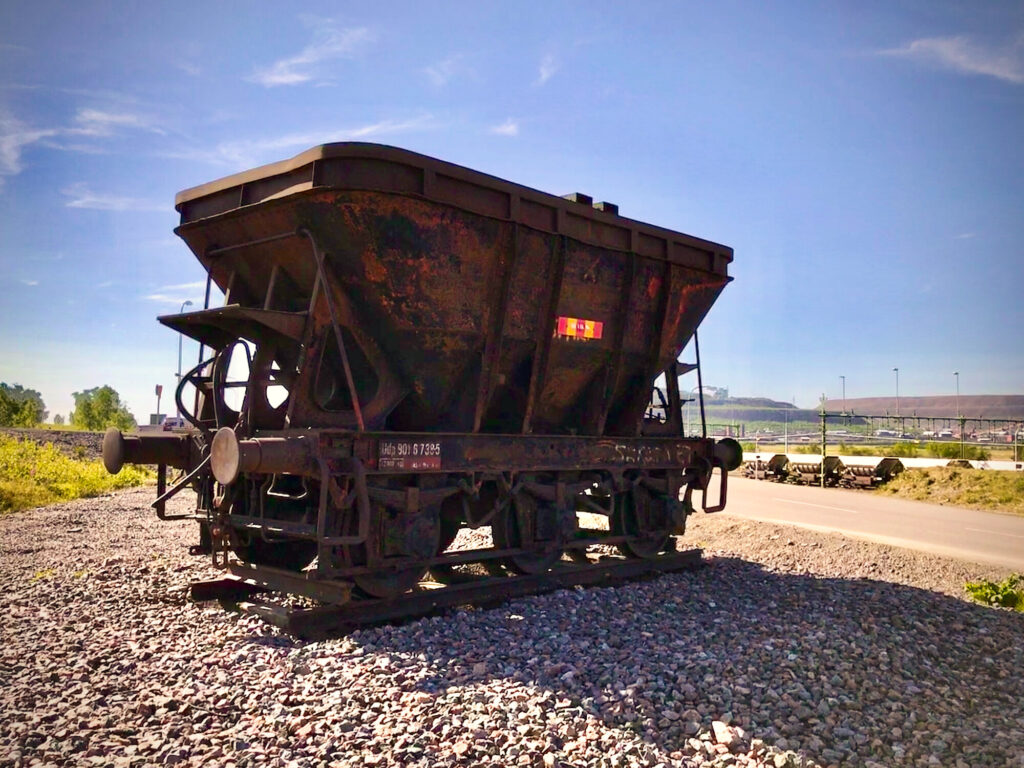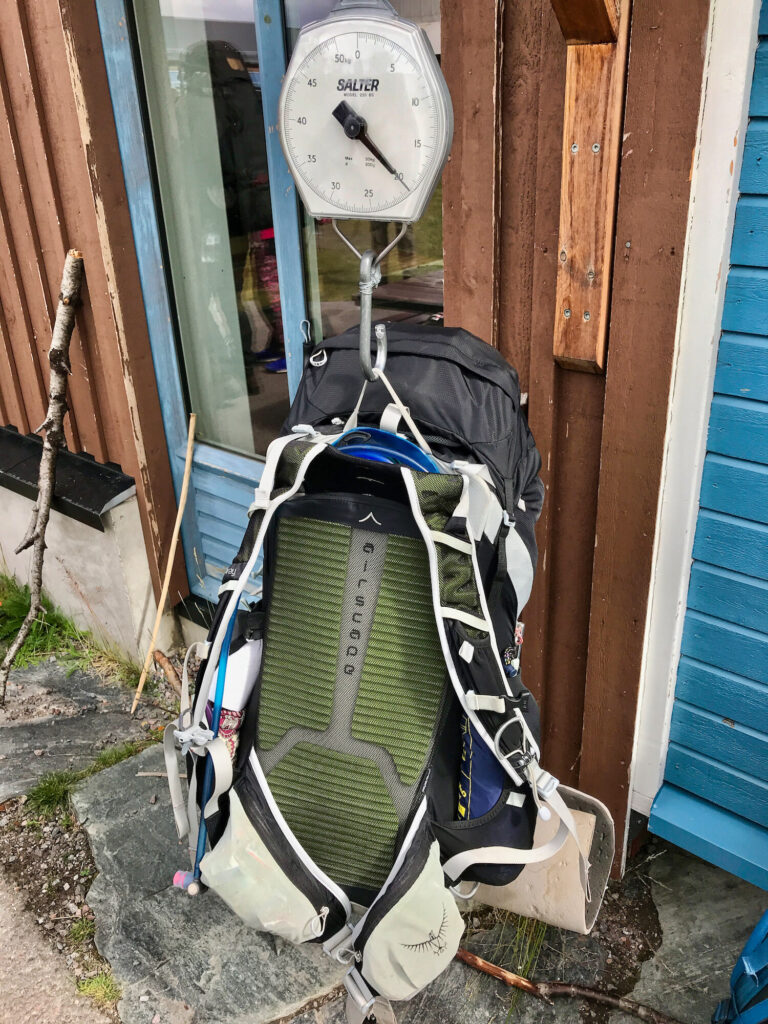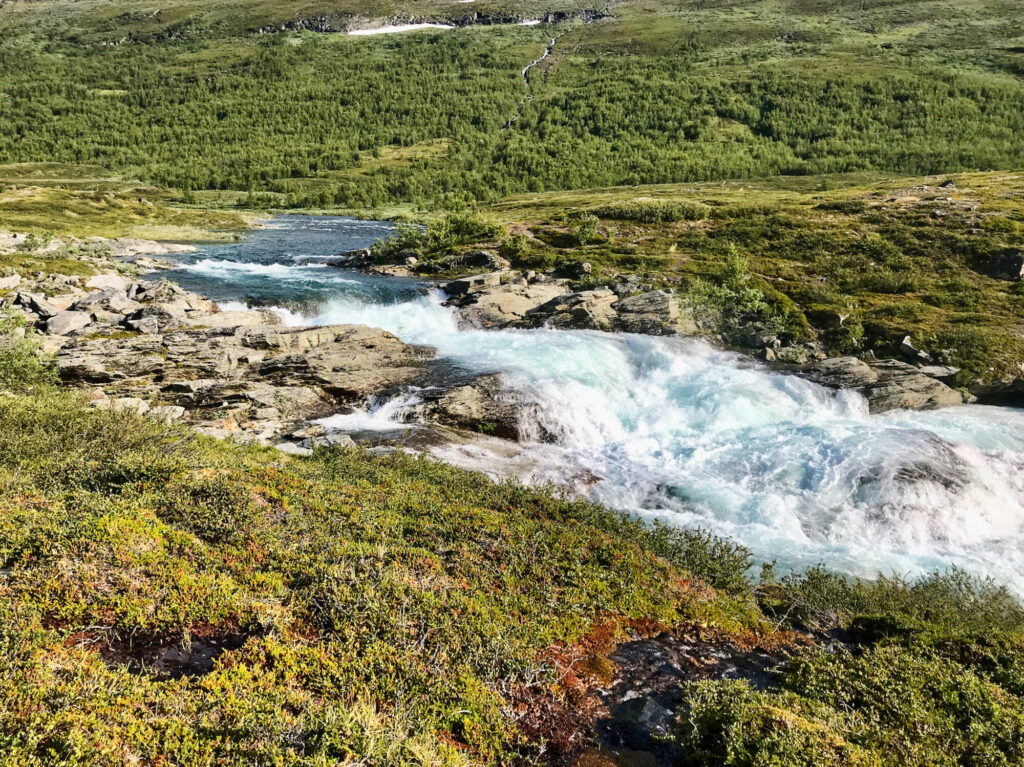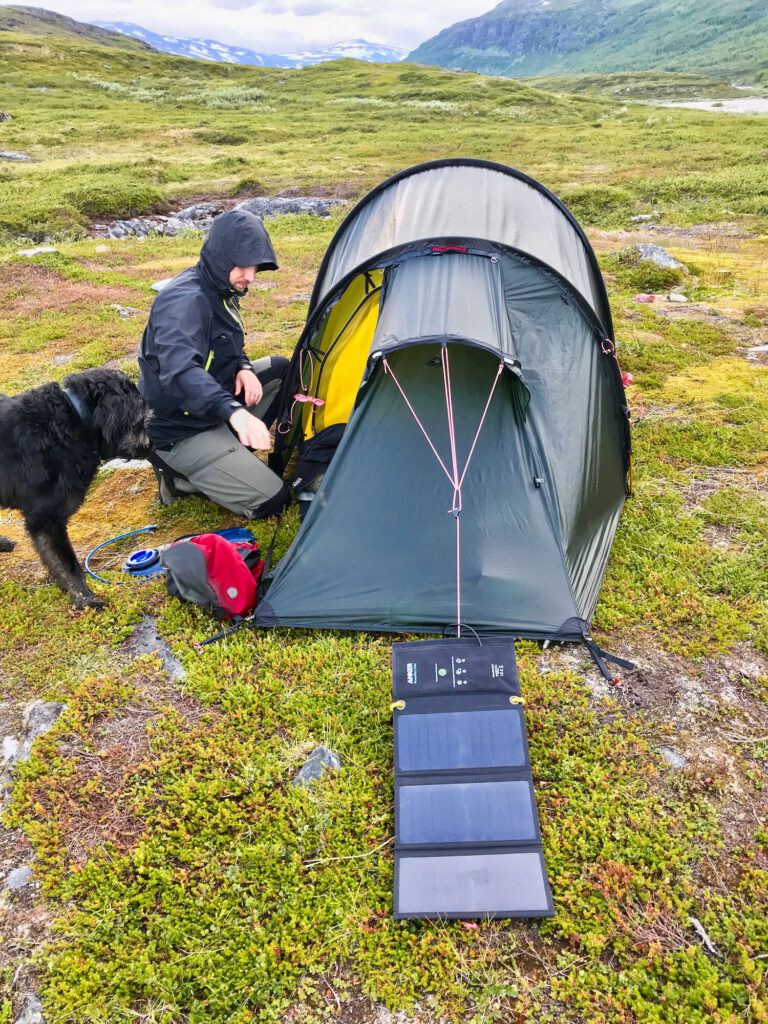The starting point of this year’s hike is the ore town of Kiruna. On the previous day we already traveled there by plane via Stockholm. After a somewhat restless night and a good breakfast at the SPiS Hostel in Kiruna, we set off for the city’s tourist information office. Here we store Lando’s flight box and my suitcase before we take the bus to the train station, from where we will head to the starting point of our tour – Abisko. Arriving at the station we find out that our train is delayed – like actually always up here. But we are on vacation, got time and the weather is perfect.
Accommodation recommendation for Kiruna
If you want to spend a night in Kiruna, we recommend the SPiS. It is situated in the city centre and within walking distance from the bus station or the tourist information office. Here you can find cheap shared rooms with hostel standard, but also hotel rooms. You can also bring your dog, just make sure you inform the hotel in advance. Don’t miss the breakfast and the delicious food in the restaurant!
www.spiskiruna.se
Since the train station in the city of Kiruna has been demolished because of the expanding ore mine, there is currently a temporary station just outside the center. Shuttle buses go there from the city center. But you can also walk the way, which takes about 20 minutes. Read more about the experiences we had with the station in Kiruna and the reliability of the SJ trains here.
We look for a comfortable spot on a meadow at the edge of the station. On a bench we spread our stuff and have something to eat, research again the weather for the next days and let our souls dangle. We are only disturbed by the urban lawn mower crew, which mows with its loudly rattling gasoline lawn mowers exactly the meadow we are sitting on.
Gepäckunterbringung Kiruna
Am Flughafen von Kiruna gibt es keine Möglichkeit Gepäckstücke zu lagern. In manchen Hotels kann man dies auf Nachfrage tun (im SPiS Hostel geht dies zum Beispiel). In der Touristeninformation in Kiruna kann man auch Gepäck lagern. Große, sperrige Gepäckstücke wie eine Hundebox sind kein Problem, der Raum ist recht groß. Die Nutzung kostet 20 SEK pro Tag und Gepäckstück. Eine Unterbringung oder Abholung des Gepäcks ist nur während der Öffnungszeiten möglich.
We arrive in Abisko with a delay of two hours
With a delay of about two hours we finally reach Abisko Tourist Station. From there we take a detour to the Fjällstation where we fill up our water supplies and weigh our backpacks. Manuel’s backpack adds up to 24kg, Katharina’s to 20kg and Lando’s to 5.5kg. Quite heavy, but we have a lot of food and dog food with us!
STF Abisko Turiststation
Located at the northern end of Lake Abiskojaure, the Abisko Tourist Station is the starting point for many activities. From the railway station Abisko Turiststation it is a 10 minute walk to get there. There is also a road connection. A scale tells you how much weight you are about to carry on your hike!
Beds: >100
Shop: Yes
Sauna: Yes
Payment: Cash or credit card
More information: WIFI, Rental, Café, Breakfast, www.swedishtouristassociation.com
We have some little starting problems on our way through the Abisko National Park
After weighing, we set off for Abisko National Park. We decide not to take the Kungsleden, which leads from here on the same path as the Nordkalottleden to the Abiskojaure hut because of the many hikers. However, there is an alternative: there is also a path on the west bank of the Abiskojåkka and this is exactly the one we choose. First we hike through a birch forest. Even at this early point we notice that there are definitely more mosquitoes this year than last year. After a few minutes we grab the mosquito oil. Freshly covered with the oil, we begin to climb up the first incline. Our untrained legs quickly complain about the heavy backpacks. The weather with 22 degrees does the rest, so that we are completely sweaty pretty quickly. The sauna in Ulla Allakas will be excellent as it is the next washing opportunity two days from now.
The stage is unspectacular, after the ascent it continues mostly flat to a larger river, the Kårsajåkka. Here the national park, in which you can only spend the night in designated places, ends and we have already considered camping around this point. Therefore, we decide to look for a suitable camp site on the other side of the river.
Where is the bridge over the Kårsajåkka?
Unfortunately, the bridge marked on the map is no longer there. Somewhat perplexed, we look at the last remains of the foundations and the raging river behind it, which rushes downhill in rapids. How are we supposed to get to the other side? A look at the map reveals that the river widens a bit upstream. We decide to try it there and set off. Soon we see a couple on the bank: he is fording the river and she is taking off her pants. And that’s exactly what we do now: we take off our pants and socks, then put our shoes back on and look for the best way through the water. The river is maximum knee-deep at this point, but the current in the middle is still quite strong.
This is my first river crossing of this dimension and I notice that I lose my balance in very fast flowing water if I only look down. It helps me to stop now and then and have a look at the horizon. Nevertheless, I fall over at a shallow spot. It probably looked funny, and fortunately I didn’t get very wet. So everything went well.
Alternative route recommendation without river crossing
If you, like us, do not want to hike on the Kungsleden to Abiskojaure, you should follow the path along the banks of the Abiskojåkka until you come across the Kårsajåkka. Here it can be easily crossed on a new bridge. Then turn west into the valley of the Kårsajåkka and follow it upstream to the old bridge. You can find the exact route in the map at the end of the article.
Pretty exhausting such a river crossing
The Kårsajåkka is quite wide at this point and we are still unexperienced in fording. So it takes a good half hour until we safely reach the other bank. Since the river crossing has been quite exhausting for us, we decide to camp directly afterwards. Other hikers must have had this idea before us, because there are many well-trodden paths and excellent camp spots with small benches made of wooden planks. Today, however, we are all alone in this place.
After we have set up our camp, we watch two men with a child walking indecisively up and down the other bank. They finally decide against fording while the mosquitoes force us into the tent.
STF Abisko Turiststation
Description

Day 1: Abisko Turiststation - Kårsajåkka
Profile
Description
Like two years before, we start at the STF Abisko Turiststation. It is easy to reach by train and we can buy last supplies there. We leave Kungsleden after only a few meters and change to the western bank of Abiskojåkka. For a short time we walk parallel to the river before we slowly turn west into the valley of the Kårsajåkka. We cross the river next to an old bridge that no longer exists. At higher water levels the crossing here is very challenging or even impossible.
Day 1: Alternative route
Profile
Description
If you want to go this way today, you should follow the path along the bank of Abiskojåkka until you meet Kårsajåkka. Here it can be easily crossed on a new bridge. Then turn west into the valley of the Kårsajåkka and follow it upstream to the old bridge.
Campspot at Kårsajåkka
Description

















